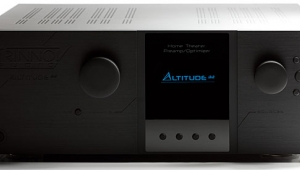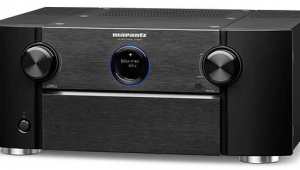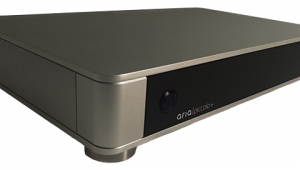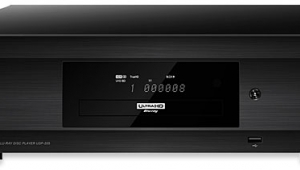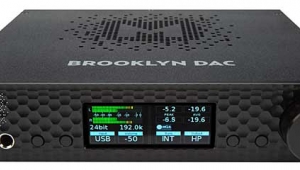| Columns Retired Columns & Blogs |
Music in the Round #36
The first time I ever heard stereo sound, it was in a shop on Manhattan's Radio Row. In addition to the Studer staggered-head tape deck, the system consisted of pairs of McIntosh C8 preamps, MC60 power amps, and monster Bozak B-310 speakers. I can still picture the room and almost hear the sound. I was then an impecunious high-schooler, and while I always strived to buy the best equipment I could afford, I unfortunately was never able to own any of these iconic products. However, when I saw McIntosh's new MC303 three-channel power amp glowing brightly on silent display at the 2008 CEDIA Expo, a light bulb went on over my head: I'd been assessing a series of three-channel and monoblock amps, and the MC303 would fit nicely into my New York City system.
Footnote 1: The McIntosh MC303 costs $10,000. McIntosh Laboratory, Inc., 2 Chambers Street, Binghamton, NY 13903-2699. Tel: (800) 538-6576, (607) 723-3512. Fax: (607) 724-0549. Web: www.mcintoshlabs.com.
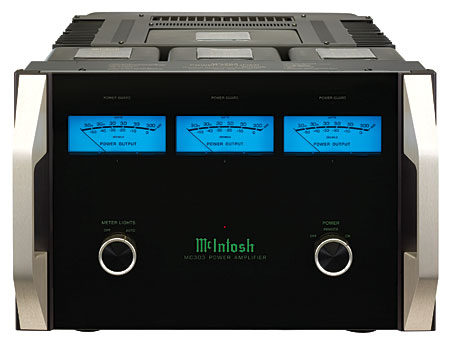
The McIntosh MC303 ($10,000) is an impressively large, heavy power amp rated at 300Wpc with an output-current capability of 60 amps. McIntosh states that this, along with its more than 200 joules of energy storage, empowers the MC303 to pump out up to 1200Wpc on music bursts, regardless of speaker load. One reason is McIntosh's employment of their proprietary output autoformers to optimize power transfer for 2, 4, or 8 ohm speakers. That transformers can do this is well accepted, but to do it well, those transformers must be of very high quality and quite large. The MC303 measures 17.75" wide by 12.375" high by 22" deep and weighs 155 lbs, which makes it as big and heavy as JL Audio's Fathom f113 subwoofer. The MC303 has now joined the f113 as one of the only two products my delivery guys have ever complained about. At least two people are needed to unpack and position it.
Once in place, the MC303 looked gorgeous. On the front are three of McIntosh's signature blue power-level meters, along with gold-rimmed knobs for meter illumination and power. There's a substantial handle at each end of the front panel, and a Power Guard LED above each meter. I never saw the LEDs even flicker. A top view reveals the major amplifier blocks: Across the front of the chassis are the three autoformers, with the main amp behind them. Having these up front probably makes for better weight distribution when using the front handles, but a picture of the underside of the chassis, probably never to be seen by mere mortals, shows the output wiring from transformers to speaker terminals. Shouldn't they be at the back, to minimize the wiring to the output terminals?
Inside the main amp, the power transformer is central, sitting atop a stack of 27,000µF/100V capacitors, and flanked on the left, right, and rear by the three channels of power amp and heatsink. On the back are RCA and XLR inputs and a bank of four multiway binding posts for each channel. Setup was almost trivially easy, requiring no instructions. I say "almost" because the speaker terminals were too closely spaced for my fingers, especially using the requisitely heavy speaker cables. Nonetheless, all one need do is connect the inputs, outputs, and AC, and enjoy it.
I used the XLR inputs and decided to first try the MC303's 4 ohm taps. B&W's official but simple spec for my 802D speakers is "8 ohms nominal, 3.5 ohms minimum." John Atkinson's measurements show that the 802's impedance remains below 4 ohms from 60 to 800Hz. That's a pretty meaty chunk of the midrange, and I figured there might be real advantage in favoring it. Also, the electrical phase angle ran from –50° to about +50° in that same range. The rest of the spectrum could probably fend for itself.

Lucky or smart—who knows? From the get-go to the moment I type this, the MC303 has elevated the sound of the B&W 802Ds, as well as the rest of my system and room, to a standard I have rarely experienced. The most obvious difference was that the low-frequency hump, shown in the direct response from the woofers in JA's graph (fig.4), was no longer audible. Even without Meridian's room-response correction, the bass was smoother and, because of this, subjectively extended. I could now more easily hear and appreciate the 802D's bass capabilities, which are substantial. (The speaker's performance via the McIntosh's 8 ohm taps was just marginally less superb, and noticeable mostly in the 3–4kHz range, where the ear is most sensitive, with recordings of the female voice.) That smoothness extended through the midrange and all the way up, through, and past the crossovers without revealing even the tiniest seam.
Now, I know that McIntosh has a reputation for such smoothness, coupled to a slightly warm character and a wide, deep soundstage. In fact, some have attributed the depth of the soundstage to the tonal warmth, but I found no instance in which the presentation could be correlated with the brightness of the recording, even when I played recordings specifically chosen for their treble emphasis. Examples include the Classic Records DADs derived from Bert Whyte's Everest recordings, which at times I've found to be somewhat glaring in the upper midrange, played at 24-bit/96kHz from the modified Oppo DV-980H universal player, through a prototype ESS-9018-based DAC. De Falla's Three-Cornered Hat, as performed by Enrique Jorda and the London Symphony Orchestra (DAD, Everest/Classic HDADPlus 2019), was as spectacularly wide, deep, and detailed as before—but now, through the MC303, so much more open and relaxed that I relived the thrill I felt when I discovered the original LP so many decades ago. When I switched to the three-channel tracks of the De Falla—or, better yet, of Malcolm Sargent and the LSO's recording of Shostakovich's Symphony 9 (DAD, Everest/Classic HDADPlus 2018)—the MC303 and 802Ds approached the relaxed spaciousness and transparency of master tapes.
In three channels—or, abetted by a McCormack amp/B&W 804S combo, in five channels—my system played louder, clearer, and cleaner than ever with the MC303. The killer discs used were the three-channel version of Rimsky-Korsakov's Scheherazade with Fritz Reiner and the Chicago Symphony (SACD/CD, RCA Living Stereo 66377), and Christoph Eschenbach and the Philadelphia Orchestra's five-channel edition of Saint-Saëns' "Organ" Symphony (SACD/CD, Ondine ODE 1094-5). And look, ma, no subwoofer—even on the latter's powerful opening piece, Samuel Barber's Toccata Festiva for organ and orchestra!
Though I was thoroughly smitten with the MC303, it didn't exactly leave all other amps in the dust. Driven by Bel Canto's Ref 1000/II, the B&W 802Ds sounded firmer in the extreme bass and a bit less forgiving in the treble. The amps' audible differences seemed to parallel their distinct looks. Sitting next to the McIntosh, each Bel Canto monoblock reminded me of a tight, powerful, eager Audi S-8 parked next to a strong, massive, capable Cadillac Escalade. The Classé CA-5200, on the other hand, is almost in the same weight class as the McIntosh, was more forgiving of recorded emphases at both frequency extremes, and had great transparency throughout the audioband (automotive equivalent: a Mercedes S-65). What nosed the McIntosh ahead of these able performers was not a matter of balance or even of power, as all of these amps delivered enough for me; rather, the MC303 seemed to erase the 802Ds' crossover transitions and create an equally seamless frontal soundstage.
Still, I was faced with a paradox. I can hear and describe how each of the amps I have lately auditioned compare, and acknowledge that others have particular advantages over the MC303 with the B&W 802Ds—advantages I could also hear with PSB's Imagine T speakers. However, there was a gripping "rightness" about the musical performance of the MC303-802D combination that was not so apparent with the McIntosh-PSB, and that trumped rational analysis. This so troubled the logical side of my brain that I may have to keep the McIntosh MC303, if only to attempt to reconcile left brain with right. And that would be so much more enjoyable than sending it back.
Sony SCD-XA5400ES SACD/CD player
I remember when, sometime in the late 1980s, I decided to buy my last turntable. I also recall that, since that purchase, I have bought three more turntables. So when I say that Sony's new SCD-XA5400ES ($1499.99) looks like the last of its kind, or the last SACD/CD player that we or Sony would need...take it with a grain of salt.
Footnote 1: The McIntosh MC303 costs $10,000. McIntosh Laboratory, Inc., 2 Chambers Street, Binghamton, NY 13903-2699. Tel: (800) 538-6576, (607) 723-3512. Fax: (607) 724-0549. Web: www.mcintoshlabs.com.
Footnote 2: The Sony SCD-XA5400ES costs $1499.99. Sony Electronics Inc., 16530 Via Esprillo, San Diego, CA 92127. Tel: (800) 222-7669. Web: www.sony.com.
- Log in or register to post comments


